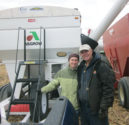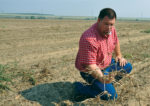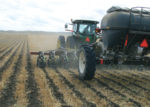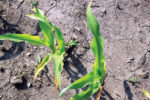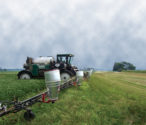Advertise Follow Us
ARTICLES
The latest high-clearance cover-crop seeder debuting at VanTilburg Farms holds 3,000 pounds of product and can apply cover crops, wheat or urea into standing crops.
Read More
Matching Nitrogen Rates To Strip-Till Profitability
Through research, Minnesota strip-tiller David Legvold and college senior Emma Cornwell found the most profitable rate of sidedressed liquid 28% isn’t always the highest rate.
Read More
Switch To Strip-Till, Cover Crops Friendly To Yields And Profits
For Ontario farmer Blake Vince, taking a leap with strip-till practices helped him improve corn yields, preserve soil moisture and reduce expenditures on high-dollar fuel and fertilizer.
Read More
Strip-Till Helps 22,000-Acre Farm Run More Efficiently
Reduced tillage passes, timely planting and erosion control are big strip-till benefits for Watts Brothers Farms as it grows vegetables to keep food packaging and production plants running.
Read More
Maintain Strip-Till Rigs To Boost 2013 Yields
Reviewing and replacing mechanical parts and checking precision-ag components, software and rate controllers can increase your chances of profitability in the next growing season.
Read More
Corn Stover Removal And No-Till: A Balancing Act
No-tillers that follow guidelines can remove some stover from continuous-corn fields and still warm up soils, improve nitrogen efficiency and retain organic matter.
Read More
‘WORK THE ZONE’ To Boost Strip-Till Fertility
Placing fertilizer both shallow and deep, and planting in the middle of the berm, can maximize your strip-till corn yields.
Read More
Fixing Sulfur Shortages Can Boost No-Till Yields
Knowledge of vulnerable soil types and field conditions, and targeted sulfur applications, can increase crop outputs.
Read More
From ‘Walking The Beans’ To Herbicide-Resistant Crops
No-tillers can learn a few things about weed control from the early days of no-till to help them in today’s challenging weed environment.
By Dan Zinkland
posted on
November 1, 2011
| Posted in Crop Protection, Nutrient Management, Soil Health
Read More
Bio Strip-Till: Best of Both Worlds
Using cover crops with strip-tillage helps growers improve the crop-row environment, build soil organic matter and protect fields from erosion.
Read More
Top Articles
Current Issue
No-Till Farmer
Get full access NOW to the most comprehensive, powerful and easy-to-use online resource for no-tillage practices. Just one good idea will pay for your subscription hundreds of times over.
Soil Health Principle 4: Continual Living Plant
Regenerating Your Profits: No-Till, Covers & Livestock
Good or Bad, We’re in for Some Interesting Times for Conservation Ag
Must Read Free Eguides
Download these helpful knowledge building tools
- How Beneficial Insects, Pollinators Can Boost No-Till Resilience
- How No-Till Improves Your Land Value
- 5 Pillars for No-Till Farming Effectively, Efficiently
- Making the Precision Basics Even Better with Implement Guidance
Videos
What to Expect at 2025 National Strip-Tillage Conference
The 2025 National Strip-Tillage Conference takes place July 31-August 1 in Iowa City. In this video, past attendees and speakers share why they keep coming back! Head to StripTillConference.com to download the program and register for the 2025 National Strip-Tillage Conference!
Events
Conservation in Action Tour 2025 -- Sioux Falls, S.D.
Date: 05/06/25
Location:
View Event
Top Directory Listings
Needham Ag Technologies, LLC
Needham Ag understands the role of technology in making better use of limited resources within a specific environment by drawing on a wealth of global experience to overcome the challenges facing today's farmers, manufacturers and dealers.
Titan International, Inc
Titan offers a full line of wheels, tires and undercarriage products for a wide variety of off-the-road equipment.
The Andersons PureGrade
The Andersons grows enduring relationships through extraordinary service, a deep knowledge of the market, and a knack for finding new ways to add value as we have done for nearly 70 years.



